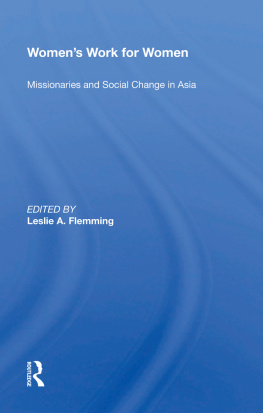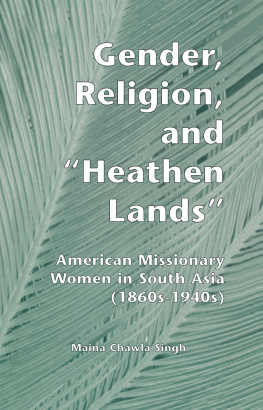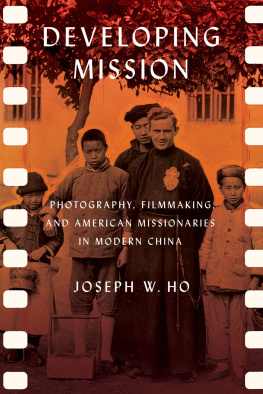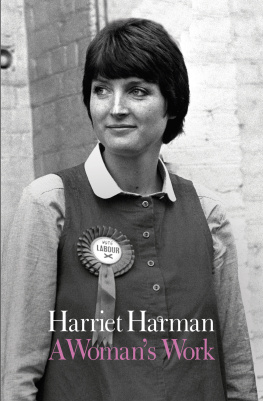First published 1989 by Westview Press
Published 2018 by Routledge
52 Vanderbilt Avenue, New York, NY 10017
2 Park Square, Milton Park, Abingdon, Oxon OX14 4RN
Routledge is an imprint of the Taylor & Francis Group, an informa business
Copyright 1989 by Taylor & Francis
All rights reserved. No part of this book may be reprinted or reproduced or utilised in any form or by any electronic, mechanical, or other means, now known or hereafter invented, including photocopying and recording, or in any information storage or retrieval system, without permission in writing from the publishers.
Notice:
Product or corporate names may be trademarks or registered trademarks, and are used only for identification and explanation without intent to infringe.
Library of Congress Cataloging-in-Publication Data
Women's work for women: missionaries and social change in Asia/
edited by Leslie A. Flemming.
p. cm.
Includes index.
ISBN 0-8133-7708-0
1. Women missionariesAsia. 2. MissionsAsia. I. Flemming,
Leslie A.
BV2610.W63 1989
266'.0088042dc20 89-9192
CIP
ISBN 13: 978-0-367-21382-4 (hbk)
Introduction: Studying Women Missionaries in Asia
Leslie A. Flemming
When the leaders of the Woman's Foreign Mission Society of the American Presbyterian Church chose the title Woman's Work for Woman for their mission magazine in 1870, they chose the phrase that both overseas missionaries and their supporters in north America used most often to describe women's missionary activity In evoking that phrase, the title of this book recaptures the view of missions held by most north American Protestant women throughout the nineteenth century. Believing in both the uniqueness of their own religious and socially reformist missions at home and abroad and in the clear superiority of American civilization, these women devoutly hoped that the lifelong, sacrificial efforts of women missionaries on behalf of women in the "heathen" lands of Asia, Africa and the Middle East would lead to real changes in those women's lives. Moved by their hopes and compassion for their sisters overseas, Protestant women founded and supported such a wide variety of women's missionary organizations that by the early twentieth century the women's missionary movement was the largest organized women's movement in north America and was responsible for sending and supporting two-thirds of the overseas mission force.
Despite their numbers, women missionaries have been largely overlooked by contemporary scholars. Most church historians and scholars of missions in Asia have focused on changing theologies of mission and the development of governance structures in Asian churches. Well into the twentieth century, church policy discouraged women from participating in either of these activities. Women's historians studying the changes in Anglo-American and European women's roles have generally dealt with the dynamics of those changes in their home settings, focusing on such issues as suffrage, temperance, education, and women's entrance into the professions and ignoring women's pursuit of new roles through mission activity. Meanwhile, area studies scholars have tended to study the internal forces generating changes in the roles of women in Asian societies, ignoring the contributions of mission-based institutions.
Because of the relative invisibility of women missionaries in contemporary scholarship, this volume breaks new ground. First, the essays here contribute fresh data to the study of nineteenth- and twentieth-century mission history. Further, they expand our understanding of contemporary women's history by suggesting both an overseas dimension to the changes that occurred in Anglo-American and European women's roles and a contribution by external forces to changes in Asian women's roles. Finally, these essays raise historiographical questions that illuminate for scholars in church history, women's history and area studies, as well as thoughtful general readers, the writing and reading of contemporary history.
Nineteenth- and Twentieth-Century Mission History
Often based almost entirely on official church documents, standard histories of missions have tended to concentrate on official church structures and male-dominated evangelical enterprises, glossing over women's activities. Relying on a wider variety of sources, the essays in this volume substantially extend our understanding of the dynamics of the mission presence in Asia. First, these essays detail the heavy mission investment in educational and medical institutions for women, most of which were under the direct supervision of women missionaries. They also describe the domestic evangelism initiated and carried out by women. In particular, Geoffrey Burkhart's vivid portraits of the Danish missionaries show that this domestic evangelism often produced intimate bonds between Asian and missionary women not possible in other settings. In addition, several biographical accounts of missionary women who spent their entire working lives in Asia trace ties between missionaries and Asian Christian families that spanned several generations.
Collectively, these essays also shed light on the tension in nineteenth-and twentieth-century missions between evangelization and civilization. While, as William Hutchison argues, liberal Protestant theologies of mission exchanged the triumphalist, strictly evangelical orientation characteristic of the early nineteenth century for the more accommodating, socially-oriented approach of the twentieth century,their need both to preach the Gospel and to establish the social institutions they believed would prepare the soil for the reception of that Gospel. Traditionally excluded from public evangelization by the Pauline injunctions against women preaching, yet responsive to the call to engage in evangelical activities, some women, like Christine Belz who worked in north India, engaged in free-lance evangelization, conversing with women and men in a variety of public and private settings. As Ruth Compton Brouwer, Marjorie King, and I show, others engaged exclusively in domestic evangelization, often working side by side with Asian Bible women. Still others attempted a more indirect evangelism, either, as King and I suggest, through Bible lessons in schools and medical facilities, or, as Burkhart suggests, through the force of their own personal example.
More characteristically, however, because of their exclusion from public evangelical activities, and because of their identification with domestic, educational and health-related activities in north American culture, most women missionaries responded more strongly to the call to be civilizers, characterizing themselves as agents of change and emphasizing the "uplifting" nature of their activities. In their view, as King's and my chapters show, the examples of their own domestic arrangements, especially their conjugal marriages, their child-raising methods, their skills in cooking and sewing, and their attention to domestic hygiene, were powerful civilizing forces. While King argues that women missionaries in China downplayed the element of social change in their work, when they perceived that Chinese men felt threatened by their activities with Chinese women, other women missionaries characterized both educational institutions for women, as Brouwer and Dorothy Robins-Mowry suggest, and women's medical institutions, as Sara Tucker argues, as significant agents of change in women's roles.









